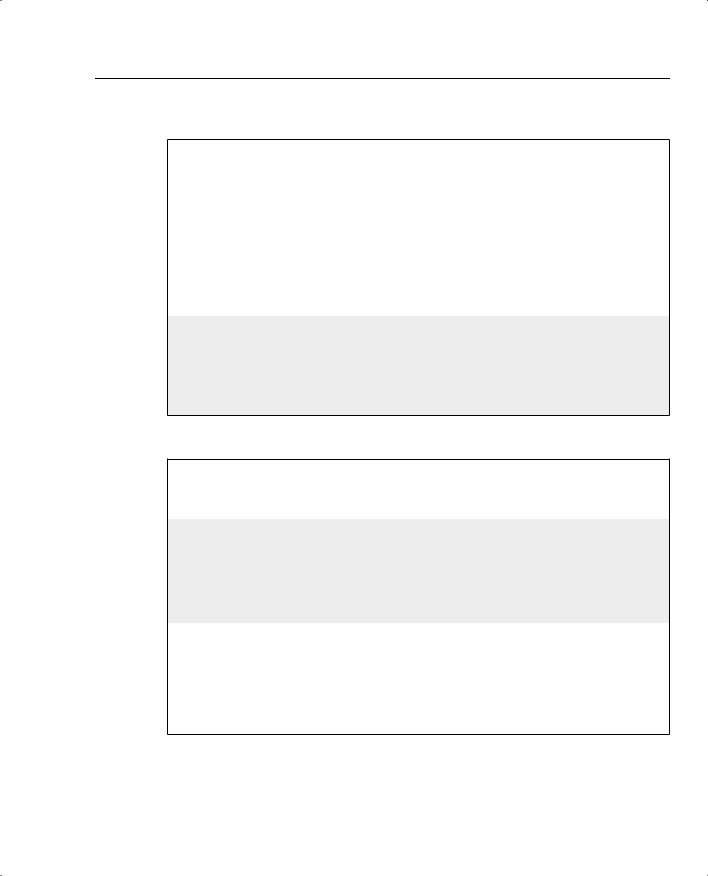
- •QoS Overview
- •“Do I Know This Already?” Quiz
- •QoS: Tuning Bandwidth, Delay, Jitter, and Loss Questions
- •Foundation Topics
- •QoS: Tuning Bandwidth, Delay, Jitter, and Loss
- •Bandwidth
- •The clock rate Command Versus the bandwidth Command
- •QoS Tools That Affect Bandwidth
- •Delay
- •Serialization Delay
- •Propagation Delay
- •Queuing Delay
- •Forwarding Delay
- •Shaping Delay
- •Network Delay
- •Delay Summary
- •QoS Tools That Affect Delay
- •Jitter
- •QoS Tools That Affect Jitter
- •Loss
- •QoS Tools That Affect Loss
- •Summary: QoS Characteristics: Bandwidth, Delay, Jitter, and Loss
- •Voice Basics
- •Voice Bandwidth Considerations
- •Voice Delay Considerations
- •Voice Jitter Considerations
- •Voice Loss Considerations
- •Video Basics
- •Video Bandwidth Considerations
- •Video Delay Considerations
- •Video Jitter Considerations
- •Video Loss Considerations
- •Comparing Voice and Video: Summary
- •IP Data Basics
- •Data Bandwidth Considerations
- •Data Delay Considerations
- •Data Jitter Considerations
- •Data Loss Considerations
- •Comparing Voice, Video, and Data: Summary
- •Foundation Summary
- •QoS Tools and Architectures
- •“Do I Know This Already?” Quiz
- •QoS Tools Questions
- •Differentiated Services Questions
- •Integrated Services Questions
- •Foundation Topics
- •Introduction to IOS QoS Tools
- •Queuing
- •Queuing Tools
- •Shaping and Policing
- •Shaping and Policing Tools
- •Congestion Avoidance
- •Congestion-Avoidance Tools
- •Call Admission Control and RSVP
- •CAC Tools
- •Management Tools
- •Summary
- •The Good-Old Common Sense QoS Model
- •GOCS Flow-Based QoS
- •GOCS Class-Based QoS
- •The Differentiated Services QoS Model
- •DiffServ Per-Hop Behaviors
- •The Class Selector PHB and DSCP Values
- •The Assured Forwarding PHB and DSCP Values
- •The Expedited Forwarding PHB and DSCP Values
- •The Integrated Services QoS Model
- •Foundation Summary
- •“Do I Know This Already?” Quiz Questions
- •CAR, PBR, and CB Marking Questions
- •Foundation Topics
- •Marking
- •IP Header QoS Fields: Precedence and DSCP
- •LAN Class of Service (CoS)
- •Other Marking Fields
- •Summary of Marking Fields
- •Class-Based Marking (CB Marking)
- •Network-Based Application Recognition (NBAR)
- •CB Marking show Commands
- •CB Marking Summary
- •Committed Access Rate (CAR)
- •CAR Marking Summary
- •Policy-Based Routing (PBR)
- •PBR Marking Summary
- •VoIP Dial Peer
- •VoIP Dial-Peer Summary
- •Foundation Summary
- •Congestion Management
- •“Do I Know This Already?” Quiz
- •Queuing Concepts Questions
- •WFQ and IP RTP Priority Questions
- •CBWFQ and LLQ Questions
- •Comparing Queuing Options Questions
- •Foundation Topics
- •Queuing Concepts
- •Output Queues, TX Rings, and TX Queues
- •Queuing on Interfaces Versus Subinterfaces and Virtual Circuits (VCs)
- •Summary of Queuing Concepts
- •Queuing Tools
- •FIFO Queuing
- •Priority Queuing
- •Custom Queuing
- •Weighted Fair Queuing (WFQ)
- •WFQ Scheduler: The Net Effect
- •WFQ Scheduling: The Process
- •WFQ Drop Policy, Number of Queues, and Queue Lengths
- •WFQ Summary
- •Class-Based WFQ (CBWFQ)
- •CBWFQ Summary
- •Low Latency Queuing (LLQ)
- •LLQ with More Than One Priority Queue
- •IP RTP Priority
- •Summary of Queuing Tool Features
- •Foundation Summary
- •Conceptual Questions
- •Priority Queuing and Custom Queuing
- •CBWFQ, LLQ, IP RTP Priority
- •Comparing Queuing Tool Options
- •“Do I Know This Already?” Quiz
- •Shaping and Policing Concepts Questions
- •Policing with CAR and CB Policer Questions
- •Shaping with FRTS, GTS, DTS, and CB Shaping
- •Foundation Topics
- •When and Where to Use Shaping and Policing
- •How Shaping Works
- •Where to Shape: Interfaces, Subinterfaces, and VCs
- •How Policing Works
- •CAR Internals
- •CB Policing Internals
- •Policing, but Not Discarding
- •Foundation Summary
- •Shaping and Policing Concepts
- •“Do I Know This Already?” Quiz
- •Congestion-Avoidance Concepts and RED Questions
- •WRED Questions
- •FRED Questions
- •Foundation Topics
- •TCP and UDP Reactions to Packet Loss
- •Tail Drop, Global Synchronization, and TCP Starvation
- •Random Early Detection (RED)
- •Weighted RED (WRED)
- •How WRED Weights Packets
- •WRED and Queuing
- •WRED Summary
- •Flow-Based WRED (FRED)
- •Foundation Summary
- •Congestion-Avoidance Concepts and Random Early Detection (RED)
- •Weighted RED (WRED)
- •Flow-Based WRED (FRED)
- •“Do I Know This Already?” Quiz
- •Compression Questions
- •Link Fragmentation and Interleave Questions
- •Foundation Topics
- •Payload and Header Compression
- •Payload Compression
- •Header Compression
- •Link Fragmentation and Interleaving
- •Multilink PPP LFI
- •Maximum Serialization Delay and Optimum Fragment Sizes
- •Frame Relay LFI Using FRF.12
- •Choosing Fragment Sizes for Frame Relay
- •Fragmentation with More Than One VC on a Single Access Link
- •FRF.11-C and FRF.12 Comparison
- •Foundation Summary
- •Compression Tools
- •LFI Tools
- •“Do I Know This Already?” Quiz
- •Foundation Topics
- •Call Admission Control Overview
- •Call Rerouting Alternatives
- •Bandwidth Engineering
- •CAC Mechanisms
- •CAC Mechanism Evaluation Criteria
- •Local Voice CAC
- •Physical DS0 Limitation
- •Max-Connections
- •Voice over Frame Relay—Voice Bandwidth
- •Trunk Conditioning
- •Local Voice Busyout
- •Measurement-Based Voice CAC
- •Service Assurance Agents
- •SAA Probes Versus Pings
- •SAA Service
- •Calculated Planning Impairment Factor
- •Advanced Voice Busyout
- •PSTN Fallback
- •SAA Probes Used for PSTN Fallback
- •IP Destination Caching
- •SAA Probe Format
- •PSTN Fallback Scalability
- •PSTN Fallback Summary
- •Resource-Based CAC
- •Resource Availability Indication
- •Gateway Calculation of Resources
- •RAI in Service Provider Networks
- •RAI in Enterprise Networks
- •RAI Operation
- •RAI Platform Support
- •Cisco CallManager Resource-Based CAC
- •Location-Based CAC Operation
- •Locations and Regions
- •Calculation of Resources
- •Automatic Alternate Routing
- •Location-Based CAC Summary
- •Gatekeeper Zone Bandwidth
- •Gatekeeper Zone Bandwidth Operation
- •Single-Zone Topology
- •Multizone Topology
- •Zone-per-Gateway Design
- •Gatekeeper in CallManager Networks
- •Zone Bandwidth Calculation
- •Gatekeeper Zone Bandwidth Summary
- •Integrated Services / Resource Reservation Protocol
- •RSVP Levels of Service
- •RSVP Operation
- •RSVP/H.323 Synchronization
- •Bandwidth per Codec
- •Subnet Bandwidth Management
- •Monitoring and Troubleshooting RSVP
- •RSVP CAC Summary
- •Foundation Summary
- •Call Admission Control Concepts
- •Local-Based CAC
- •Measurement-Based CAC
- •Resources-Based CAC
- •“Do I Know This Already?” Quiz
- •QoS Management Tools Questions
- •QoS Design Questions
- •Foundation Topics
- •QoS Management Tools
- •QoS Device Manager
- •QoS Policy Manager
- •Service Assurance Agent
- •Internetwork Performance Monitor
- •Service Management Solution
- •QoS Management Tool Summary
- •QoS Design for the Cisco QoS Exams
- •Four-Step QoS Design Process
- •Step 1: Determine Customer Priorities/QoS Policy
- •Step 2: Characterize the Network
- •Step 3: Implement the Policy
- •Step 4: Monitor the Network
- •QoS Design Guidelines for Voice and Video
- •Voice and Video: Bandwidth, Delay, Jitter, and Loss Requirements
- •Voice and Video QoS Design Recommendations
- •Foundation Summary
- •QoS Management
- •QoS Design
- •“Do I Know This Already?” Quiz
- •Foundation Topics
- •The Need for QoS on the LAN
- •Layer 2 Queues
- •Drop Thresholds
- •Trust Boundries
- •Cisco Catalyst Switch QoS Features
- •Catalyst 6500 QoS Features
- •Supervisor and Switching Engine
- •Policy Feature Card
- •Ethernet Interfaces
- •QoS Flow on the Catalyst 6500
- •Ingress Queue Scheduling
- •Layer 2 Switching Engine QoS Frame Flow
- •Layer 3 Switching Engine QoS Packet Flow
- •Egress Queue Scheduling
- •Catalyst 6500 QoS Summary
- •Cisco Catalyst 4500/4000 QoS Features
- •Supervisor Engine I and II
- •Supervisor Engine III and IV
- •Cisco Catalyst 3550 QoS Features
- •Cisco Catalyst 3524 QoS Features
- •CoS-to-Egress Queue Mapping for the Catalyst OS Switch
- •Layer-2-to-Layer 3 Mapping
- •Connecting a Catalyst OS Switch to WAN Segments
- •Displaying QoS Settings for the Catalyst OS Switch
- •Enabling QoS for the Catalyst IOS Switch
- •Enabling Priority Queuing for the Catalyst IOS Switch
- •CoS-to-Egress Queue Mapping for the Catalyst IOS Switch
- •Layer 2-to-Layer 3 Mapping
- •Connecting a Catalyst IOS Switch to Distribution Switches or WAN Segments
- •Displaying QoS Settings for the Catalyst IOS Switch
- •Foundation Summary
- •LAN QoS Concepts
- •Catalyst 6500 Series of Switches
- •Catalyst 4500/4000 Series of Switches
- •Catalyst 3550/3524 Series of Switches
- •QoS: Tuning Bandwidth, Delay, Jitter, and Loss
- •QoS Tools
- •Differentiated Services
- •Integrated Services
- •CAR, PBR, and CB Marking
- •Queuing Concepts
- •WFQ and IP RTP Priority
- •CBWFQ and LLQ
- •Comparing Queuing Options
- •Conceptual Questions
- •Priority Queuing and Custom Queuing
- •CBWFQ, LLQ, IP RTP Priority
- •Comparing Queuing Tool Options
- •Shaping and Policing Concepts
- •Policing with CAR and CB Policer
- •Shaping with FRTS, GTS, DTS, and CB Shaping
- •Shaping and Policing Concepts
- •Congestion-Avoidance Concepts and RED
- •WRED
- •FRED
- •Congestion-Avoidance Concepts and Random Early Detection (RED)
- •Weighted RED (WRED)
- •Flow-Based WRED (FRED)
- •Compression
- •Link Fragmentation and Interleave
- •Compression Tools
- •LFI Tools
- •Call Admission Control Concepts
- •Local-Based CAC
- •Measurement-Based CAC
- •Resources-Based CAC
- •QoS Management Tools
- •QoS Design
- •QoS Management
- •QoS Design
- •LAN QoS Concepts
- •Catalyst 6500 Series of Switches
- •Catalyst 4500/4000 Series of Switches
- •Catalyst 3550/3524 Series of Switches
- •Foundation Topics
- •QPPB Route Marking: Step 1
- •QPPB Per-Packet Marking: Step 2
- •QPPB: The Hidden Details
- •QPPB Summary
- •Flow-Based dWFQ
- •ToS-Based dWFQ
- •Distributed QoS Group–Based WFQ
- •Summary: dWFQ Options

Classification and Marking Tools 207
Example 3-8 PBR Marking Sample 2: VoIP, NetMeeting Audio/Video, HTTP URLs, and Everything Else (Continued)
route-map voip-routemap, permit, sequence 30 Match clauses:
ip address (access-lists): http-acl Set clauses:
ip precedence immediate
Policy routing matches: 834 packets, 1007171 bytes route-map voip-routemap, permit, sequence 40
Match clauses: Set clauses:
ip precedence routine
Policy routing matches: 8132 packets, 11263313 bytes
The output of the show ip policy command lists only sparse information. The show route-map command enables you to view statistical information about what PBR has performed. This command lists statistics for any activities performed by a route map, including when one is used for PBR. Notice that the four sets of classification criteria seen in the configuration are listed in the highlighted portions of the show route-map output, as are packet and byte counters.
PBR Marking Summary
PBR provides another classification and marking tool that examines packet header information to classify and mark packets. PBR is unique compared to the other tools in that it can classify based on information about the route that would be used for forwarding a packet. However, PBR has fewer options for matching header fields for classification as compared with the other tools.
PBR can mark IP precedence, QoS group, as well as the ToS bits. Refer to Table 3-17, in the summary for this chapter, for a complete list of classification and marking fields used by PBR.
PBR provides a strong option for classification and marking in two cases. For applications when marking based on routing information is useful, PBR can look at details about the route used for each packet, and make marking choices. The other application for PBR marking is when policy routing is already needed, and marking needs to be done at the same time. For more general cases of classification and marking, CB marking or CAR is recommended.
VoIP Dial Peer
IOS voice gateways provide many services to connect the packetized, VoIP network to nonpacketized, traditional voice services, including analog and digital trunks. IOS gateways perform many tasks, but one of the most important tasks is to convert from packetized voice to nonpacketized voice, and vice versa. In other words, voice traffic entering a router on an analog or digital trunk is not carried inside an IP packet, but the IOS gateway converts the incoming

208 Chapter 3: Classification and Marking
voice to a digital signal (analog trunks only) and adds the appropriate IP, UDP, and RTP headers around the digital voice (both analog and digital trunks). Conversely, when a VoIP packet arrives, and the voice needs to be sent out a trunk, the IOS gateway removes the packet headers, converts the voice to analog (analog trunks only), and sends the traffic out the trunk.
Although this book does not attempt to explain voice configuration and concepts to much depth, some appreciation for IOS gateway configuration is required for some of the functions covered in this book. In particular, Chapter 8, “Call Admission Control and QoS Signaling,” which covers Voice call admission control (CAC), requires a little deeper examination of voice. To understand classification and marking using dial peers, however, only a cursory knowledge of voice configuration is required. Consider Figure 3-20, for instance, which shows two analog IOS voice gateways, R1 and R4, along with Examples 3-9 and 3-10, which show the pertinent configuration on R1 and R4.
Figure 3-20 Network with Two Analog Voice Gateways
Mark
X |
Y |
Z |
Mark All VoIP on the dial-peer as IP
Precedence 5
Client1 |
Server1 |
|
|
|
|
|
SW1 |
|
R1 |
|
s1/0 |
|||||
|
|
|
|
|
|
|
||||||||
|
|
|
|
|
|
|
|
|
|
|
|
|
|
|
|
|
|
|
|
|
|
|
|
|
|
|
|
|
|
|
|
|
|
|
|
|
|
|
|
|
|
|
|
|
|
|
|
|
|
|
|
|
|
|
|
|
|
|
|
|
|
|
|
|
|
|
|
|
|
|
|
|
|
|
1001 1002
s0/0 R3 |
SW2 |
|
|
|
|
|
|
|
|
|
|
|
|||
|
|
|
|
|
|||
|
|
|
|
|
|
|
|
R4
Mark



 X
X



 3001 3002
3001 3002 
 Y
Y 









 Z
Z
Mark All VoIP on the dial-peer as IP Precedence 5

Classification and Marking Tools 209
Example 3-9 R1 Voice Gateway Configuration
hostname R1
!
int fastethernet 0/0
ip address 192.168.1.251 255.255.255.0
!
dial-peer voice 3001 voip destination-pattern 3001
session target ipv4:192.168.3.254
!
dial-peer voice 3002 voip destination-pattern 3002
session target ipv4:192.168.3.254
!
dial-peer voice 1001 pots destination-pattern 1001 port 3/0
!
dial-peer voice 1002 pots destination-pattern 1002 port 3/1
Example 3-10 R4 Voice Gateway Configuration
hostname R4
!
int fastethernet 0/0
ip address 192.168.3.254 255.255.255.0
!
dial-peer voice 1001 voip destination-pattern 1001
session target ipv4:192.168.1.251
!
dial-peer voice 1002 voip destination-pattern 1002
session target ipv4:192.168.1.251
!
dial-peer voice 3001 pots destination-pattern 3001 port 3/0
!
dial-peer voice 3002 pots destination-pattern 3002 port 3/1

210 Chapter 3: Classification and Marking
The highlighted portions of the examples focus on the configuration for the physical voice ports on R1, and the VoIP configuration on R4. Both R1 and R4 use dial-peer commands to define their local analog voice trunks and to define peers to which VoIP calls can be made. In Example 3-9, for instance, the highlighted portion of the configuration shows R1’s configuration of the two local analog lines. The two highlighted dial-peer statements use the keyword pots, which stands for plain-old telephone service. The pots keyword implies that the ports associated with this dial peer are traditional analog or digital telephony ports. The physical analog ports are correlated to each dial peer with the port command; in each of these configurations, a two-port FXS card sits inside slot 3 of a 1760-V router. Finally, on R1, the phone number, or dial pattern, associated with each of the analog ports is configured. With just the highlighted configuration in R1, voice calls could be placed between the two extensions (x1001 and x1002).
To place calls to extensions 1001 and 1002 from R4, the dial-peer commands highlighted in Example 3-10 are required. These two dial-peer commands use a voip keyword, which means this dial peer configures information about an entity to which VoIP calls can be placed. The phone number, or dial pattern, is defined with the destination-pattern command again—notice that extensions 1001 and 1002 are again configured. Finally, because these two dial peers configure details about a VoIP call, a local physical port is not referenced. Instead, the sessiontarget ipv4:192.168.1.251 command implies that when these phone numbers are called, to establish a VoIP call, using the IP version 4 IP address shown.
Similarly, R4 defines the local phone numbers and ports for the locally connected phones, and R1 defines VoIP dial peers referring to R4’s phones, so that calls can be initiated from R1.
Dial-peer classification and marking, when you know how to configure the basic dial-peer parameters, is easy. POTS dial peers refer to analog or digital trunks, over which no IP packet is in use—so there is nothing to mark. On VoIP dial peers, the dial peer refers to the IP address of another gateway to which a call is placed. So, by placing the ip precedence 5 dial-peer subcommand under each voip dial-peer, the packets generated for calls matching each dial peer will be marked with IP precedence 5. Example 3-11 lists the R4 configuration, with these changes made; the equivalent changes would be made to R1 as well.
Example 3-11 R4 Voice Gateway Configuration
hostname R4
!
interface fastethernet 0/0
ip address 192.168.3.254 255.255.255.0
!
dial-peer voice 1001 voip destination-pattern 1001
session target ipv4:192.168.1.251 ip precedence 5
no vad
!
dial-peer voice 1002 voip destination-pattern 1002
session target ipv4:192.168.1.251

Classification and Marking Tools 211
Example 3-11 R4 Voice Gateway Configuration (Continued)
ip precedence 5 no vad
!
dial-peer voice 3001 pots destination-pattern 3001 port 3/0
!
dial-peer voice 3002 pots destination-pattern 3002 port 3/1
In the example, the highlighted text shows the ip precedence 5 commands under each voip dial-peer. Packets created for VoIP calls for the configured dial patterns of 1001 and 1002 will be marked with IP precedence 5. The identical commands would be added to R1’s configuration on the VoIP dial peers to achieve the same effect.
Beginning in IOS Releases 12.2(2)XB and 12.2(2)T the ip precedence command has been replaced with the ip qos dscp command. This allows the dial peer to set the IP precedence or the DSCP value for VoIP payload and signaling traffic. Also keep in mind that the current DQOS exam, at the time this book was published, was based on IOS 12.1(5)T—so this command would not be on the current exam. Check the URLs listed in the Introduction for any possible changes.
The command uses the following syntax:
ip qos dscp [number | set-af | set-cs | default | ef][media | signaling]
Table 3-16 outlines the meaning of the parameters of the command.
Table 3-16 IP QoS DSCP Command Options
IP QoS DSCP Options |
Function |
|
|
number |
DSCP value. Valid entries are from 0 to 63. |
|
|
set-af |
Sets DSCP to assured forwarding bit pattern. Acceptable values are as |
|
follows: |
|
AF11, AF12, AF13, AF21, AF22, AF23, AF31, AF32, AF33, AF41, AF42, |
|
AF43 |
|
|
set-cs |
Sets DSCP to class selector code point. Acceptable values are as follows: |
|
CS1, CS2, CS3, CS4, CS5, CS6, CS7 |
|
|
default |
Sets DSCP to default bit pattern 000000. |
|
|
ef |
Sets DSCP to expedited forwarding bit pattern 101110. |
|
|
media |
Applies the specified DSCP value to the media payload packets. |
|
|
signaling |
Applies the specified DSCP value to the signaling packets. |
|
|

212 Chapter 3: Classification and Marking
The ip qos dscp command enables you to have much more granular control of how a VoIP packet is marked than the ip precedence command, while providing a method to preserve backward compatibility. Examples 3-12 and 3-13 show how R1 and R4 can be configured to use the ip qos dscp command to mark voice payload traffic with a DSCP value of EF and voice signaling traffic with a DSCP value of AF31. Figure 3-21 shows the now-familiar network, with the new criteria listed.
Figure 3-21 Mark Voice Payload Traffic
Mark
X |
Y |
Z |
Mark Voice Signaling Traffic on the dial-peer as IP DSCP AF31
Mark Voice Payload Traffic on the dial-peer as IP DSCP EF
Client1 |
Server1 |
|
|
|
|
|
SW1 |
|
R1 |
|
s1/0 |
|||||
|
|
|
|
|
|
|
||||||||
|
|
|
|
|
|
|
|
|
|
|
|
|
|
|
|
|
|
|
|
|
|
|
|
|
|
|
|
|
|
|
|
|
|
|
|
|
|
|
|
|
|
|
|
|
|
|
|
|
|
|
|
|
|
|
|
|
|
|
|
|
|
|
|
|
|
|
|
|
|
|
|
|
|
|
1001 1002
s0/0 R3 |
SW2 |
|
|
|
|
|
|
|
|
|
|
|
|||
|
|
|
|
|
|||
|
|
|
|
|
|
|
|
R4
Mark



 X
X



 3001 3002
3001 3002 
 Y
Y 









 Z
Z
Mark Voice Signaling Traffic on the dial-peer as IP DSCP AF31
Mark Voice Payload Traffic on the dial-peer as IP DSCP EF
Example 3-12 R1 IP QoS DSCP Dial-Peer Configuration
hostname R1
!
int fastethernet 0/0
ip address 192.168.1.251 255.255.255.0

Classification and Marking Tools 213
Example 3-12 R1 IP QoS DSCP Dial-Peer Configuration (Continued)
!
dial-peer voice 3001 voip destination-pattern 3001 ip qos dscp ef media
ip qos dscp af31 signaling session target ipv4:192.168.3.254
!
dial-peer voice 3002 voip destination-pattern 3002 ip qos dscp ef media
ip qos dscp af31 signaling session target ipv4:192.168.3.254
!
dial-peer voice 1001 pots destination-pattern 1001 port 3/0
!
dial-peer voice 1002 pots destination-pattern 1002 port 3/1
Example 3-13 R4 IP QoS DSCP Dial-Peer Configuration
hostname R4
!
int fastethernet 0/0
ip address 192.168.3.254 255.255.255.0
!
dial-peer voice 1001 voip destination-pattern 1001 ip qos dscp ef media
ip qos dscp af31 signaling session target ipv4:192.168.1.251
!
dial-peer voice 1002 voip destination-pattern 1002 ip qos dscp ef media
ip qos dscp af31 signaling session target ipv4:192.168.1.251
!
dial-peer voice 3001 pots destination-pattern 3001 port 3/0
!
dial-peer voice 3002 pots destination-pattern 3002 port 3/1
